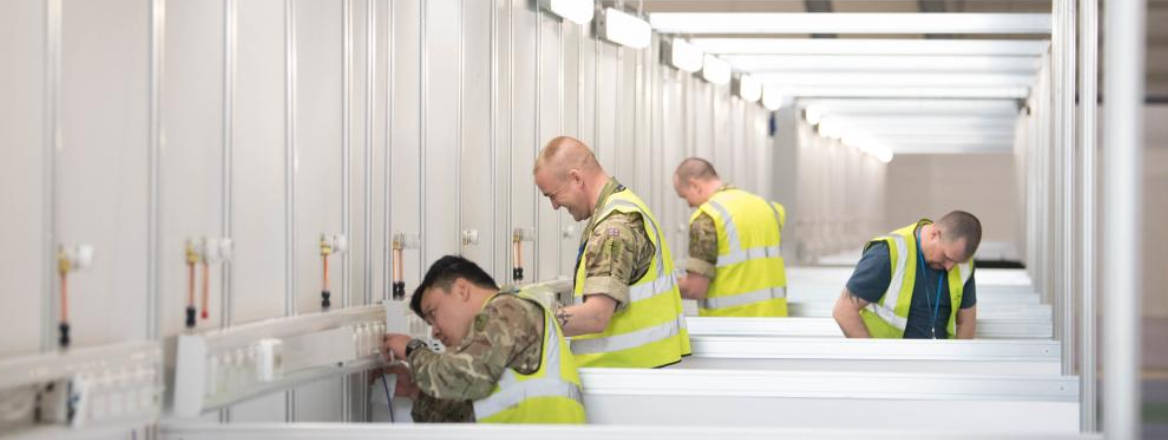Turning to the military for assistance has become commonplace in the coronavirus pandemic. Governments should be careful how they do this.
The coronavirus pandemic has brought much of the world to a standstill. As the number of infections continues to climb, governments – from China and Russia, to Italy, Spain and France, or the US and UK – are turning to the military for assistance. The military’s robust crisis management, planning and adaptive manpower make it an exceptional tool in an emergency. But Defence is also a finite resource, and we must be careful how we spend it.
Core Tasks Remain Core
The first responsibility of the military is providing a shield against external adversaries. Already during the coronavirus outbreak we have seen an uptick in strikes in Iraq from militant groups targeting coalition forces, a growing presence of Russian surface combatants in the channel and a surge in cyber attacks and disinformation activity. Defence’s primary task continues as the country locks down, and the military must keep enough of its force available to confront opportunistic adversaries.
The second consideration is that the impact of throwing Defence into the breach against coronavirus goes far beyond the duration of the crisis. UK training activities in Kenya and Canada have been called off, exercises in Norway have been curtailed and NATO’s flagship Exercise European Defender has been all but cancelled. This will put strain on units maintaining qualifications and certification to fulfil key warfighting roles in 12–24 months’ time, and rescheduling cancelled training costs money, which may be scarce with a recession anticipated.
Know Your Limits, Aim for Clear Purposes
A third vital factor is that while the military can mobilise mass quickly, there is a limit to its capabilities. The British Army is bringing 20,000 troops – over a quarter of the force – to graduated readiness to deal with the coronavirus pandemic. Although planners and technical specialists have been drawn from all three services, the bulk of the burden will fall on the Army. Bringing enough troops to readiness has required the cancellation of leave, and a range of other measures, to ensure troops can mobilise in 24–72 hours, depending on the need.
Once those troops are committed, there won’t be more available if the UK wishes to continue to meet other critical Defence tasks. Furthermore, the military will be reluctant to mobilise reserves, because this could draw personnel from civilian services. For this reason, the first commitment of military resources has been planners, who have been working across Whitehall and with regional resilience councils to map out critical bottlenecks in supply chains, capabilities or skills that Defence – and only Defence – can fill.
One of the most important questions for these planners is to understand where Defence is not the solution. For example, the Army could deploy drivers to feed the 1.5 million people identified as highly vulnerable and ordered to remain at home. As an available solution, this may be attractive to some policymakers. But it would be a massive misallocation of military resources when there is a large, and currently not employed, workforce of civilian delivery drivers who could be mobilised by local councils. Military drivers, by contrast, who can be quickly qualified to move critical supplies, have been utilised for moving oxygen and personal protective equipment at scale; something that civilian drivers cannot currently do.
A further consideration is that, in the UK, the military response to the coronavirus pandemic is carried out under the rubric of Military Aid to the Civil Authorities. This empowers the military to work under the direction of civilian agencies. There has been a lot of speculation about field hospitals. A field hospital is a military organisation that draws reserves from the NHS. By contrast, the setting up of the Nightingale Hospital in the Excel Exhibition Centre is an NHS-led project that the Army is supporting. Battlefield medical technicians are supporting the preparation of facilities, while engineers lay oxygen pipes and ensure sufficient water and sanitation materials, and logisticians evaluate routes for supply. But it remains a civilian effort.
This also informs how the military is likely to support the police. There has been speculation about civil unrest as the lockdown continues. Military units will be very reluctant to become involved in responding to such incidents, considering the often-tragic consequences of military riot control. However, the military will likely assist in taking over a wide range of back-end tasks from police officers to free up capacity in the event of unrest, so that the police can ensure adequate numbers of frontline personnel, with the appropriate training and equipment.
There are longer-term questions that arise from the government calling on the military in a crisis. The military will always answer the call. However, the primary role of battlefield medical technicians, military engineers, logisticians and field hospitals is to support the UK military in warfighting. What if the crisis struck at a time when the Army was deployed abroad? Would withdrawing protection and support from fighting forces in order to manage an emergency at home be accepted by the public? If not, then do we need greater crisis management capabilities within civilian agencies? As the volunteer scheme to support the NHS has demonstrated, civil society can mobilise at a scale that the military cannot match. If appropriate training and planning were in place, is this where the government should look for a response to flooding, or medical emergency?
The military provides policymakers with a flexible, reliable and highly capable tool. But just as the coronavirus crisis is raising serious questions as to our approach to supply chain resilience, small but highly centralised government and welfare provision, it should also provoke longer-term thinking about how we employ our military.
The views expressed in this Commentary are the author's, and do not represent those of RUSI or any other institution.
WRITTEN BY
Dr Jack Watling
Senior Research Fellow, Land Warfare
Military Sciences



